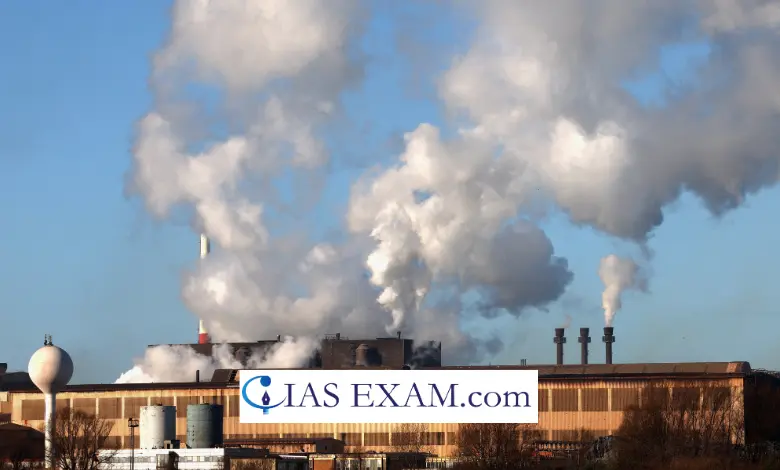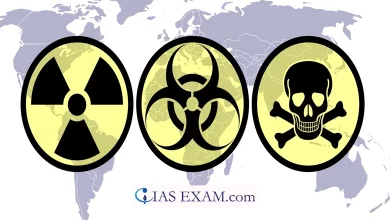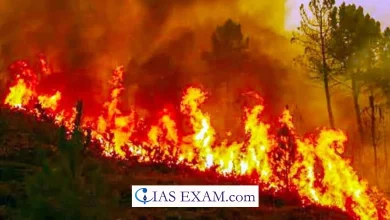Daily Current Affairs for UPSC
Global CO2 levels reached a Record High
Syllabus- Environment and Ecology [GS Paper-3]

Context
According to the National Oceanic and Atmospheric Administration (NOAA), global carbon dioxide levels reached a record high in 2023.
About the Carbon Dioxide (CO2)
- It is an important heat-trapping gas, also known as a greenhouse gas, that comes from the morection and burning of fossil fuels (which includes coal, oil, and natural gasoline), from wildfires, herbal methods like volcanic eruptions, and land use modifications like deforestation, peat emissions, and agricultural activities.
- Since the onset of industrial times in the 18th century, human activities have raised atmospheric CO2 by 50% – which means the amount of CO2 is now 150% of its rate in 1750.
- This human-caused rise is more than the natural growth found at the end of the last ice age 20,000 years ago.
Global Carbon Dioxide Levels (Current Status)
- The global average atmospheric carbon dioxide was 419.3 elements per million (ppm) in 2023, that is more than 50% higher than pre-industrial levels.
- This growth was the third biggest in the last decade.
- The increase between 2022 and 2023 was 2.8 ppm — the twelfth year in a row wherein the quantity of carbon dioxide in the environment expanded by higher than 2 ppm.
- The 2023 growth was the third-largest in the last decade and is likely a result of an ongoing growth of fossil fuel carbon dioxide emissions, along with high fire emissions probably due to the transition from La Nina to El Nino.
- El Nino and La Nina are the warm and cool phases of a recurring climate pattern across the tropical Pacific called the El Nino-Southern Oscillation (ENSO).
- In March 2024, the CO2 tiers at Mauna Loa Observatory, Hawaii, were recorded at 425.38 ppm, up from 420.99 ppm in March 2023.
- It has the longest record of direct measurements of CO2 in the environment.
Global Methane Levels (Current Status)
- Methane is emitted all through the manufacturing and transport of coal, natural fuel, and oil.
- Methane emissions also end result from cattle and other agricultural practices, land use, and by using the decay of organic waste in municipal solid waste landfills.
- Despite being less abundant than CO2, Methane is more potent at trapping heat in the environment.
- Methane levels in the atmosphere at the moment are greater than a hundred and 60% higher than their pre-industrial stage.
- It first rose in the 1980s, and nearly stabilised in the early 2000s before hastily increasing again in 2007.
- It went as much as an average of 1922.6 parts consistent with billion (ppb) in 2023 — a 10.9 ppb soar over 2022.
- The year 2023 marked the fifth-highest since 2007.
- More than 85% of the increase from 2006 to 2021 was because of increased microbial emissions generated by livestock, agriculture, human and agricultural waste, wetlands and different aquatic assets.
- The rest may be coming from fossil fuel emissions.
Global Nitrous Oxide Levels (Current Status)
- Nitrous oxide is emitted at some point of agricultural, land use, and business activities; combustion of fossil fuels and solid waste; in addition to in the course of treatment of wastewater.
- It is the 0.33-most vast human-caused greenhouse gas, and its concentrations are 25% higher than the pre-industrial level of 270 ppb.
- The current level increased by 1 ppb to 336.7 ppb in 2023.
- This growth in recent years is being traced back to the use of nitrogen fertiliser and manure from the growth and intensification of agriculture.
Impact of Rising Levels
- Without carbon dioxide, Earth’s natural greenhouse effect would be too susceptible to hold the common global surface temperature above freezing.
- By including more carbon dioxide to the atmosphere, humans are supercharging the natural greenhouse effect, causing global temperature to rise.
- The growing CO2 stages have placed us in a precarious function, mirroring atmospheric situations from the Pliocene epoch, a period more or less 4.3 million years in the past.
- During that geological duration, sea tiers were about 23 metres higher than today, and the average temperature was better than in pre-industrial instances.
- If the cutting-edge degree of emissions persists, there’s a 50% chance that global warming of 1.5°C could be surpassed in nine years.
- This is the opposite fashion needed to reverse climate change.
Conclusion
- CO₂ is the unmarried most critical greenhouse gas main to human-caused climate change.
- Although other GHGs are more effective in line with molecules in warming the planet than CO₂, the CO₂ emissions live in the atmosphere for loads to hundreds of years, making CO₂ the most important assignment in preventing climate exchange.
- The growing stages of carbon dioxide in our ecosystem are a clear indication of the urgent need for action.
- The facts from NOAA spotlight the crucial state of earth’s carbon cycle and underscore the significance of decreasing greenhouse gas emissions.
Source: The Down to Earth
UPSC Mains Practice Question
Q.Discuss global warming and mention its effects on the global climate. Explain the control measures to bring down the level of greenhouse gases which cause global warming, in the light of the Kyoto Protocol, 1997. (2022)





.png)



